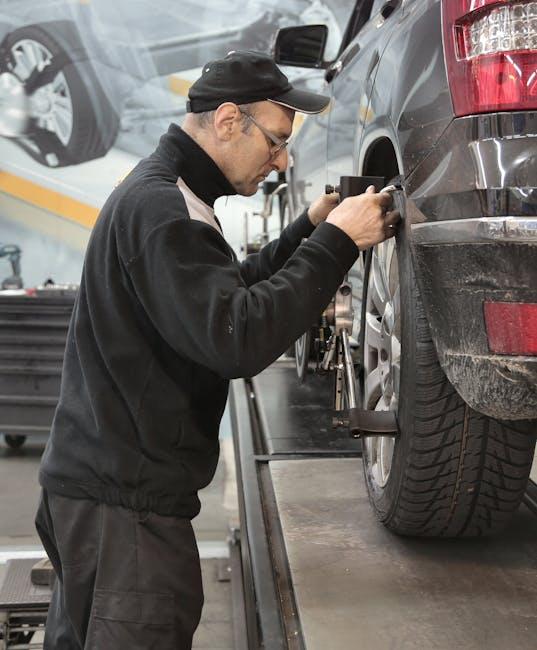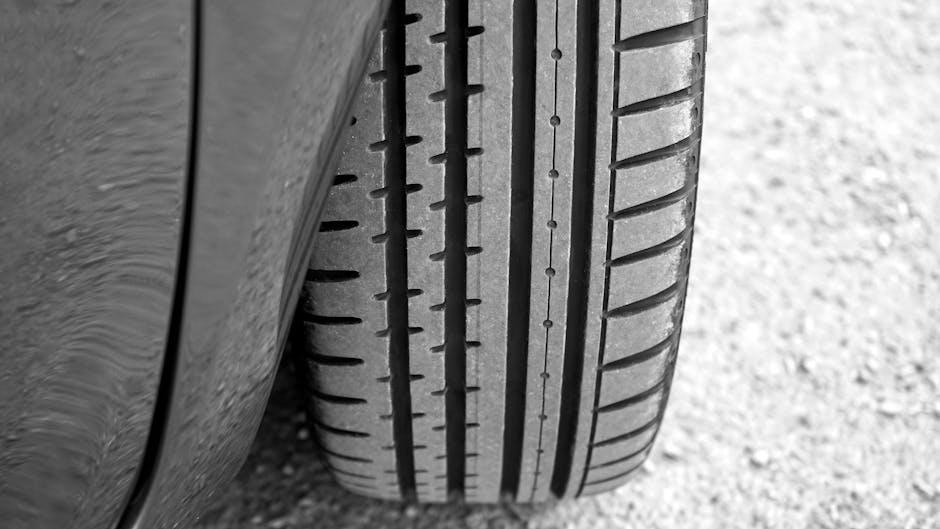Imagine cruising down a winding road, the sun setting gently on the horizon, your car responding smoothly to every turn and twist. Behind this seamless dance between driver and machine lies an often overlooked but vital factor: alignment. More than just a routine check at the mechanic’s shop, proper vehicle alignment plays a crucial role in enhancing driving safety. From ensuring steady handling to reducing tire wear and preventing unexpected skids, alignment quietly works to keep you firmly in control—transforming each journey into a safer experience. In this article, we explore how alignment improves driving safety and why it deserves a spot on every driver’s maintenance checklist.
Table of Contents
- The Crucial Role of Vehicle Alignment in Road Safety
- Understanding the Impact of Misalignment on Tire Wear and Handling
- How Proper Alignment Enhances Steering Precision and Control
- Detecting Alignment Issues Before They Compromise Safety
- Recommended Maintenance Practices to Maintain Optimal Alignment
- Technological Advances in Alignment for Safer Driving Experiences
- Q&A
- To Conclude

The Crucial Role of Vehicle Alignment in Road Safety
Proper vehicle alignment is a fundamental factor in maintaining control and stability on the road. When wheels are accurately aligned, they roll smoothly without pulling to one side, ensuring a steady trajectory and reducing driver fatigue during long journeys. Misalignment can cause uneven tire wear, which compromises traction and increases the risk of skidding or hydroplaning on wet surfaces. By keeping all wheels parallel and correctly angled, alignment helps distribute vehicle weight evenly, enhancing braking efficiency and cornering precision—both critical aspects for avoiding accidents.
Beyond the mechanics, proper alignment supports the longevity of your vehicle’s suspension and steering components, preventing costly repairs and unexpected breakdowns. Here are some key safety benefits linked to well-aligned wheels:
- Improved tire lifespan: Even tread wear means better grip and fewer blowouts.
- Responsive steering: Direct input translates to safer maneuverability.
- Enhanced fuel efficiency: Reduced rolling resistance lowers fuel consumption.
- Reduced driver strain: Consistent handling reduces the effort needed to maintain course.
| Alignment Issue | Safety Impact | Fix Frequency |
|---|---|---|
| Toe Misalignment | Uneven tire wear, poor handling | Every 12,000 miles |
| Camber Misalignment | Reduced cornering stability | Annually or after suspension work |
| Incorrect Caster | Poor steering returnability | During major suspension repair |

Understanding the Impact of Misalignment on Tire Wear and Handling
When your vehicle’s wheels are out of alignment, subtle but continuous stress is placed on the tires, causing uneven wear patterns that drastically shorten their lifespan. Typical signs include excessive wear on the inner or outer edges of tires, which often leads to frequent replacements and increased maintenance costs. Beyond the obvious financial implications, misaligned tires can unpredictably affect how your car grips the road, diminishing control especially in wet or slippery conditions. This subtle shift in handling dynamics can elevate the risk of accidents, making proper alignment not just a matter of performance, but a critical safety measure.
Key consequences of misalignment include:
- Rapid tread wear and uneven tire consumption
- Steering wheel vibration and pulling to one side
- Reduced fuel efficiency because tires aren’t rolling true
- Compromised vehicle stability during acceleration and braking
| Symptom | Cause | Recommended Action |
|---|---|---|
| Tire Wear on One Side | Incorrect Camber Angle | Realign Camber |
| Vehicle Pulls Left or Right | Toe Misalignment | Adjust Toe Settings |
| Steering Wheel Off-Center | Front-End Misalignment | Full Alignment Check |

How Proper Alignment Enhances Steering Precision and Control
Maintaining precise wheel alignment directly influences how effectively a vehicle responds to steering inputs, providing drivers with enhanced confidence behind the wheel. When the wheels are aligned correctly, the tires meet the road at the optimal angles, reducing unnecessary drag and ensuring that directional commands are executed smoothly without unwanted resistance or wandering. This precision enables sharper, more predictable handling — essential for maneuvering through tight corners or during emergency situations where split-second reactions are required.
Beyond improved responsiveness, proper alignment offers practical advantages that help prolong vehicle components and ensure consistency in driving behavior. Consider the key benefits:
- Enhanced tire longevity: Even wear patterns prevent premature tire replacement.
- Reduced driver fatigue: Less corrective steering needed during long drives.
- Consistent vehicle stability: Balanced handling under various road conditions.
| Alignment Factor | Impact on Steering |
|---|---|
| Toe Angle | Controls vehicle’s straight-line tracking and reduces tire scrubbing |
| Camber Angle | Affects cornering grip and tire contact patch |
| Caster Angle | Improves steering stability and returnability after turns |

Detecting Alignment Issues Before They Compromise Safety
Before alignment issues become a hazard on the road, there are subtle signs that savvy drivers and mechanics can spot early. Uneven tire wear, for instance, is often the first red flag—notice tread wearing down faster on one side. Another symptom includes a vehicle that pulls to one side despite having the steering wheel straightened. Additionally, vibrations through the steering wheel or an off-center steering wheel while driving straight can signal that your alignment needs a professional check. Being attentive to these indicators ensures you catch problems before they escalate.
Regular inspections offer the best defense against misalignment risks. Here’s a quick checklist of what to watch for:
- Uneven or rapid tire wear
- Steering wheel off-center
- Vehicle pulling left or right
- Steering wheel vibrations
| Symptom | Potential Cause | Safety Impact |
|---|---|---|
| Uneven Tire Wear | Misaligned wheels | Tire blowouts, poor traction |
| Off-Center Steering | Incorrect toe settings | Reduced vehicle control |
| Vehicle Pulling | Camber angle issues | Increased collision risk |
| Steering Vibrations | Alignment and balance issues | Driver fatigue, loss of control |
By proactively detecting these subtle warning signs, drivers can maintain optimal alignment and ensure their vehicle stays safe on the road miles ahead.

Recommended Maintenance Practices to Maintain Optimal Alignment
Maintaining optimal vehicle alignment is pivotal for ensuring a smooth and safe driving experience. Regularly inspecting your tires for uneven wear patterns—such as feathering or scalloping—can provide early signs that your alignment may be off. Additionally, following a consistent schedule for wheel alignments, typically every 10,000 to 12,000 miles, helps prevent gradual misalignment caused by road conditions or minor impacts. Paying attention to your steering wheel’s responsiveness and centering can also alert you to alignment issues that need immediate attention, helping you avoid dangerous handling problems on the road.
Besides professional checks, there are simple daily habits that contribute significantly to maintaining alignment. Avoiding potholes and curbing your wheels carefully reduces the risk of sudden shocks that knock your tires out of balance. Keeping your tires properly inflated not only extends their life but supports consistent alignment by ensuring even pressure distribution. Below is a quick reference table of essential maintenance steps and their benefits to alignment and driving safety:
| Maintenance Step | Frequency | Benefit to Alignment |
|---|---|---|
| Wheel alignment service | Every 10,000-12,000 miles | Corrects tire angles for stable handling |
| Tire inspection for wear | Monthly | Detects uneven patterns indicating misalignment |
| Tire pressure check | Bi-weekly | Maintains even tire wear and ride comfort |
| Careful curb approach | Every drive | Prevents sudden alignment shifts from impact |

Technological Advances in Alignment for Safer Driving Experiences
Recent innovations in vehicle alignment technology have transformed how safely cars respond on the road. Advanced sensors and computer-aided alignment machines allow technicians to achieve precision that was once unattainable. This ensures optimal tire-to-road contact, which directly affects braking performance, steering response, and overall vehicle stability. Modern real-time monitoring systems can even alert drivers to alignment issues before they compromise safety, providing peace of mind during every drive.
Key technological breakthroughs include:
- 3D laser alignment for pinpoint accuracy
- AI-powered diagnostics that predict wear patterns
- Enhanced wheel balancing systems that reduce vibrations
- Integration of alignment data with vehicle safety systems for adaptive adjustments
| Technology | Benefit |
|---|---|
| 3D Laser Alignment | Unmatched precision for longer tire life |
| AI Diagnostics | Early detection of potential alignment faults |
| Adaptive Integration | Seamless interaction with safety systems |
Q&A
Q&A: How Alignment Improves Driving Safety
Q1: What exactly is wheel alignment?
A: Wheel alignment is the precise adjustment of your vehicle’s suspension and steering components so that your wheels are perpendicular to the ground and parallel to each other. This ensures that your tires meet the road at the correct angle, maximizing control and safety.
Q2: How does alignment affect vehicle handling?
A: Proper alignment ensures that your car responds precisely to your steering inputs. When wheels are aligned correctly, the vehicle tracks straight, turns smoothly, and feels stable, reducing driver fatigue and enhancing confidence behind the wheel.
Q3: Can misalignment really be dangerous?
A: Absolutely. Misaligned wheels can cause uneven tire wear, pulling to one side, and unstable steering, increasing the risk of accidents. It can also make emergency maneuvers more difficult, putting you and others on the road at risk.
Q4: Does alignment impact tire wear and fuel efficiency?
A: Yes, misalignment causes tires to wear unevenly and more quickly, leading to frequent replacements and unsafe driving conditions. Additionally, when tires don’t roll smoothly, your engine must work harder, lowering fuel efficiency.
Q5: How often should I get my vehicle’s alignment checked?
A: It’s wise to have your alignment inspected annually or whenever you notice signs like uneven tire wear, your car pulling to one side, or after hitting a curb or pothole. Regular checks keep your driving safe and your vehicle performing optimally.
Q6: Can I drive with misaligned wheels?
A: While you might still drive, it’s like steering a boat with a crooked rudder—it’s manageable but risky. Ignoring misalignment can lead to dangerous handling, faster tire degradation, and costly repairs down the road.
Q7: Is wheel alignment a complicated or expensive fix?
A: Alignment services are relatively quick and affordable compared to the potential costs of accident repairs and premature tire replacement. Most mechanics perform this service using high-tech equipment to ensure precision.
Q8: In what ways does alignment improve overall driving safety?
A: By ensuring wheels are properly aligned, your vehicle maintains optimal grip, steering accuracy, and balance. This stability helps prevent skidding, enhances braking performance, and allows for safer navigation of curves and emergency stops.
Understanding and maintaining proper wheel alignment isn’t just about prolonging the life of your tires—it’s a crucial step toward preserving your safety on every journey. Keep your wheels aligned, and let every drive be a confident and secure one.
To Conclude
In the intricate dance between driver and machine, alignment plays a subtle yet vital role—quietly steering each journey toward safety and control. By ensuring that every wheel moves in perfect harmony, alignment doesn’t just preserve tires or improve fuel efficiency; it safeguards lives on every road. As technology advances and our understanding deepens, one truth remains clear: a well-aligned vehicle is more than a mechanical necessity—it’s a steadfast partner in the pursuit of safer driving experiences. So, the next time you take the wheel, remember that alignment is the unseen force keeping your path true and your travels secure.
